This article was originally published as a post on Strongblade's blog, the Strongblade Edge, with the title Zen and the Stage Combat Sword. This is part two of a two part article which discusses the differnces between Battle Ready and Stage Combat swords. This part covers Stage Combat swords. The post was written by award-winning author Roberto Calas.
(This is part 2 of a two-part article on the difference between battle-ready and stage-combat swords. You can find the previous article here.)

Beaker will be playing the role of Yoda.
So, in my last post, I talked about battle-ready swords. And Yoda. And I promised to reveal the secret of the crop circles in England. So, in this second part of the post, I want to address stage combat swords. And Beaker, sidekick to Dr. Bunsen Honeydew, of Muppets fame. And, as promised, I will reveal the secret of the crop circles.
But first, let's talk about stage combat.
When you battle on stage, you are trying to accomplish three things:
1. To present a skillful display of martial prowess that will impress and entertain the audience.
2. To move the story forward in an energetic fashion.
3. To not die.
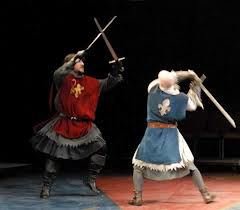
Stage combat. The timeless art of not dying.
The skillful display of martial prowess requires training, practice and choreography. Moving the story forward requires a good script and a director that understands the need for good pacing and realizes that a fight scene must not just introduce action, but also says something about the characters. And to not die requires good stage combat sword. And actors who like each other.
But what is a good theatrical combat sword?
Well, let's start by saying what it's not. A stage combat sword is very different from a battle-ready sword. You see, each sword has a completely different purpose. A battle-ready sword, historically, was meant for one thing: Killing people. A purpose directly opposed to directive 3 of stage combat. We talked last time about how tempering a sword allows it to hold a good edge, although making the blade more brittle. In stage combat, we don't want a brittle blade. We want a blade that won't send shards of metal into an audience (unless you're trying to pioneer 3D live theater, in which case you might want that, although I would consult an attorney before moving forward). In stage combat, we want a sturdy blade, one that will endure hundreds of performances, thousands of sword on sword strikes. And one that will do the least amount of damage should an accident occur. So, how do we achieve this?
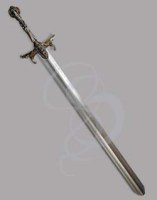
Latex and rubber. Not just a fetish anymore.
On stage, the audience will have a long time to look at the weapons, and they will expect to hear the sounds of steel on steel when swords meet. So, for the stage, you need a strong, high-carbon steel weapon. But there is one thing not everyone agrees on. And, that is, as Hamlet so eloquently stated, "To temper, or not to temper?" (Most people aren't aware that Shakespeare wrote the original version of Hamlet with that line in it.) (Editor's note: That's becauseShakespeare didn't write that. Stop making stuff up).
Some stage combat performers like tempered swords, because they have a harder surface and won't suffer so many nicks and scratches. Tempered swords also flex back to their original shape when you flex them. But, as mentioned earlier, if you flex a tempered sword too much, it may break, turning your performance into the aforementioned 3D live theater. A non-tempered sword might bend during a performance, though, which isn't going to help your audience suspend disbelief (and may symbolize bad things about your main character if he is male).
The best way to make a decision on tempering is to assess the type of sword you will be using. Many re-enactors and performers use a non-tempered, high-carbon blade that is really thick. A thicker blade is less likely to bend (which is what I tell my fiancée whenever I can).
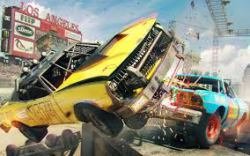
Crash cars don't have hood ornaments. Learn from this.
Regardless of whether you temper a weapon or not, there are a few things that are not optional. Your stage combat weapon should have a full tang, just like a battle ready weapon. It should also have squared or rounded thick edges, a rounded (not pointed) tip, and should *never* be sharpened (see directive 3 of stage combat).
Beaker, of Muppet fame, once said something important about stage combat weapons. He said, "Meep meep meep. Meep meep meep, meep meep–meep meep meep, meep meep Meep meep meep; meep meep.."
And I think that says just about everything you need to know about stage combat weapons. Although he left out the part about guards. You see, on a real, battle-ready sword, the guard is used only for incidental contact. On stage, there are many more sword-on-sword strikes, which means more chance of the guards being struck. Because of this, the guards on a stage combat sword should be made of very strong steel, with no decorations or plating.
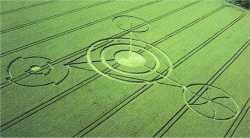
These have absolutely nothing to do with stage combat.
What about balance? We talked about how important balance is for a battle-ready sword. Is it important in a stage combat weapon? The answer is long and rather technical:
No.
Some people cling to the belief that they need a perfectly balanced weapon for stage combat, but those are the same people who think that cars should get a new paint job before taking part in a demolition derby. Safety and durability are the two most important factors in a stage combat weapon. Everything else is just lipstick and eyeliner.
Oh, and now, for the unveiling. I will reveal how the crop circles were made in England. The answer was discovered by Beaker, of Muppet fame. And I will let him tell you in his own words"
"Meep meep meep, meep meeep meep. Meep meep, meep meep meep, meep meep: Meep Meep. Meep. Meep meep."
That Beaker. He's wasted working for Honeydew

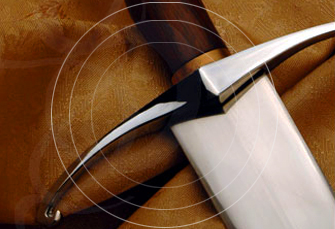
Comments
No comments yet.Add Comment